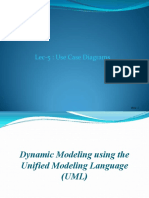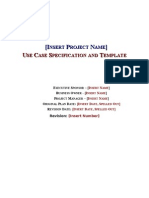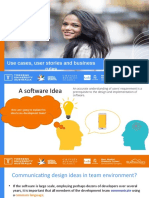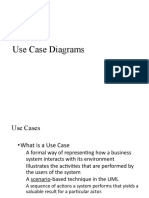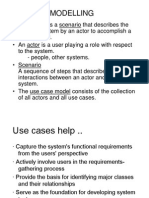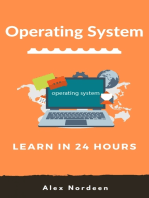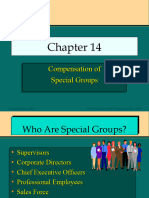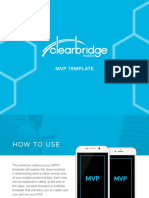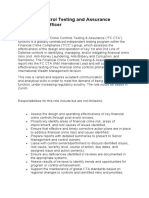02 UsecaseModel
Uploaded by
HOÀNG Nguyễn02 UsecaseModel
Uploaded by
HOÀNG NguyễnUniversity of Science, VNU-HCM
Faculty of Information Technology
Requirement Modeling
Assoc. Prof. TRAN Minh Triet
Department of Software Engineering
Introduction to Requirement Process
Problem Space
Problem
Problem
Needs
Features The system to
be built
Software Solution Space
Requirements
Traceability
Test Procedures
Design User
Doc
2
Definitions
❖ Requirement
A condition or capability to which the system must conform.
❖ Requirements management
A systematic approach to:
▪ Eliciting, organizing, and documenting requirements.
▪ Establishing and maintaining agreement between
customer/user and the project team on the changing
requirements.
3
What Do Software Requirements Specify?
Inputs Outputs
System
Design Constraints
Functions
Non-Functional
Requirements
(E.g. Performance)
(E.g. Environments)
4
UML in Context of Requirement Modeling
Business Use-
case Modeling
System Use-
case Modeling
5
Use-case Modeling
6
Objectives
❖ When you complete this module, you should be able to:
Define actor, use case, and use-case model
List the benefits of use cases
Explain how use cases fit into a requirements management
process and the software development lifecycle
7
Use cases involve a shift in thinking
From a focus on the function of To a focus on the value a
a system system must deliver for its
stakeholders
8
What Is Use-Case Modeling?
❖ Links stakeholder needs to software requirements.
❖ Defines clear boundaries of a system.
❖ Captures and communicates the desired behavior of the system.
❖ Identifies who or what interacts with the system.
❖ Validates/verifies requirements.
❖ Is a planning instrument.
Model
Use case 1
Actor 2
Use case 2
Use case 3
Use Case 2
Specification
9
A Use-Case Model is Mostly Text
The System
Use case 1
Use-Case-Model Survey Actor 1
- survey description
- list of all actors Actor 2
Use case 2
- list of all use cases
Use case 3
Actor 3
Use-Case 1 Spec Use-Case 2 Spec Use-Case 3 Spec
- brief description - brief description - brief description
- flow of events - flow of events - flow of events
10
Major Use-Case Modeling Elements
Actor
Someone/something outside the
system, acting in a role that
Actor interacts with the system
Use case
Use Case Represents something of value
that the system does for its actors
11
Actor
❖An actor represents a role that a human, hardware device, or another
system can play in relation to the system
❖An actor is external to the system
❖A complete set of actors describes all of the ways in which outside
users communicate with the system
Actor
12
What Is a Use Case?
Use Case Name
A use case defines a sequence of actions
performed by a system
that yields an observable result of value
to an actor.
13
Use cases contain software requirements
❖ Each use case
Is a coherent unit of functionality provided by a system
Describes sequences of actions that the system takes to
deliver something of value to an actor
Models a dialog between the system and actors
Is a complete and meaningful flow of events from the
perspective of a particular actor
14
Capture a use-case model
❖A use-case model is comprised of:
Use-case diagrams Use-case specifications
(visual representation) (text representation)
15
Use-case specification
❖A requirements document that contains
the text of a use case, including:
Use-case specification
A description of the flow of events
describing the interaction between
actors and the system
Other information, such as:
▪ Preconditions
▪ Postconditions
▪ Special requirements
▪ Key scenarios
▪ Subflows
16
Use-case diagram
❖Shows a set of use cases and
Use-case diagram
actors and their relationships
❖Defines clear boundaries of a The System
system
Use
Use case
case11
❖Identifies who or what interacts with Actor 1
the system Use case 2
Actor 2
❖Summarizes the behavior of the
Use case 3
system
Actor 3
17
Use cases drive software development
Use-Case Model
Realized by Verified by
Implemented
by
Design Model
Test Model
Implementation
Model 18
Benefits of use cases
❖ Give context for requirements
Put system requirements into logical sequences
Illustrate why the system is necessary
Help verify that all requirements are captured
❖ Are easy to understand
Use terminology that customers and users understand
Tell concrete stories of system use
Verify stakeholder understanding
Aid team communication and understanding
❖ Facilitate agreement with customers
❖ Facilitate the creation of test cases, documentation, and design
❖ Facilitate requirements reuse
19
Who should care about use cases?
❖Analysts
❖Customers
❖Users
❖Software architects
❖Designers
❖Testers
❖Project managers
❖Documentation writers
20
Requirements management process
IBM® Rational Unified Process® (RUP®)
Find Actors Requirements Management workflow
and Use Cases
Outline
Use Cases
Detail a Use Case
21
Review
❖What is an actor?
❖What is a use case?
❖What are some of the benefits of using use cases?
❖What is a use-case model?
❖What is a use-case diagram?
❖What is a use-case specification?
❖How does use-case modeling fit into the requirements management
process?
❖How does use-case modeling fit into the software development
lifecycle?
22
Use-case Model
23
Objectives
❖When you complete this module, you should be able to:
Describe the use-case writing process
Find and describe actors
Find and describe use cases
Relate use case
24
Process of writing use cases
Find actors Registrar
Close Registration
Find use cases Brief description: This use case allows a Registrar to
close the registration process. Courses that do not have
enough students are cancelled. The Billing System is
notified for each student in each course that is not
cancelled, so the student can be billed.
Outline a Close Registration Outline
-Flow of events
use case -Step by step
Close Registration Use-Case Specification
-Detailed Flow of Events
Detail a -Special Requirements
use case -Pre/Postconditions
25
Process of writing use cases (cont.)
Find actors
Important Note:
Use case writing is an iterative process
Find use cases
Outline a
use case
Detail a
use case
26
Process of writing use cases
Find actors
Name and briefly describe the
actors that you have found
Find use cases
Outline a
use case
Detail a
use case
27
Actors and the system boundary
❖Determine what the system boundary is
❖Everything beyond the boundary that interacts with the system is an
instance of an actor
System boundary?
Is the Accounts
Receivable System an
actor or part of the
system?
Financial
Analyst
Order Entry System ? ?
Accounts
Receivable Financial
System Analyst
28
Actors and roles
❖ An actor represents a role that a
human, hardware device, or
another system can plan in
relation to the system.
29
Find actors
❖ Who or what uses the system?
❖ Who or what gets information from this system?
❖ Who or what provides information to the system?
❖ Where in the company is the system used?
❖ Who or what supports and maintains the system?
❖ What other systems use this system?
30
Name the actor
❖ Actor names should clearly convey the
actor’s role
❖ Good actor names describe their Librarian
responsibilities
Patron Clerk
Bank
System
31
Describe the actor
Name Librarian
Brief description A person who adds a resource into a
library
Relationships with
use cases
Add Resource
Librarian
32
Review
❖How do you find actors?
33
Process of writing use cases
Find actors
Name and briefly describe the
use cases that you found
Create a use-case diagram
Find use cases Assess business values and
technical risks for use cases
Outline a
use case
Detail a
use case 34
Find use cases
What goal am I trying
to achieve by using the
system?
GOAL 1
Actor GOAL 2
35
Find use cases (cont.)
❖ What are the goals of each actor?
Why does the actor want to use the system?
Will the actor create, store, change, remove, or read data in the
system? If so, why?
Will the actor need to inform the system about external events
or changes?
Will the actor need to be informed about certain occurrences in
the system?
❖ Does the system supply the business with all of the correct
behavior?
36
Is Log in a use case?
❖By UML definition, log in is not a use case, because it does not
produce results of value to an actor.
❖However, in many cases, there is a need to capture log in separately
because it:
Captures more and more complex behaviors (security,
compliance, customer experience)
Is included in other use cases
❖Recommendation: Make an exception and capture log in as a
separate use case.
Log in
User
37
CRUD Use Cases
❖A CRUD use case is a Create, Read, Update, or Delete use case
❖Remove CRUD use cases if they are data- management use cases
that do not provide results that are of value to actors
Create a schedule
Read a schedule • Do not confuse use
Register for
cases with functions
courses
Update a schedule • Focus on value
Delete a schedule
38
Name the use case
❖A use case name should:
Be unique, intuitive, and self-explanatory
Define clearly and unambiguously the observable Register for
result of value gained from the use case courses
Be from the perspective of the actor that triggers the
use case
Describe the behavior that the use case supports
Start with a verb and use a simple verb-noun Select a
combination course to teach
Guideline: Conduct a survey to learn whether customers, business
representatives, analysts, and developers all understand the names and
descriptions of the use cases
39
Describe a use case (text description)
Name Register for Courses
Brief description The student selects the courses they wish to
attend to the next semester. A schedule of
primary and alternate courses is produced.
Relationships with actors
Register for courses
Student
40
Checkpoints for actors
✓ Have you found all of the actors?
✓ Have you accounted for and modeled all roles in the system's
environment?
✓ Is each actor involved with at least one use case?
✓ Do any actors play similar roles in relation to the system? If so,
merge them into a single actor.
41
Checkpoints for use cases
✓ The use-case model presents the behavior of the system; it is easy
to understand what the system does by reviewing the model.
✓ All use cases have been identified; the use cases collectively
account for all required behavior.
✓ The use-case model contains no superfluous behavior; all use cases
can be justified by tracing them back to a functional requirement.
✓ All CRUD use cases have been removed.
Create, Retrieve, Update, Delete
42
Checkpoints for use cases (cont.)
✓ The use cases have unique, intuitive, and explanatory names so that
they cannot be confused at a later stage. If not, change their names.
✓ Customers and users understand the names and descriptions of the
use cases.
✓ The brief description gives a true picture of the use case.
✓ Each use case is involved with at least one actor.
✓ No use cases have very similar behaviors or flows of events.
43
Use-case diagrams: communicates-association
❖ A channel of communication between an actor
and a use case
❖ A line represents a communicates-association
Actor 1
Use Case
Actor 2 Actor 3
44
Each communicates-association is a whole dialog
Student logs on to system
System approves logon
Student requests course
information
Register for
Student Courses Course
Catalog
System
System displays course list System transmits request
Student selects courses Course Catalog returns course
information
System displays approved schedule
45
Use-case diagram example
Register for Courses
Course Catalog
System
Student
Select Courses
Professor to Teach
Get Class List
for a Course
46
Review
❖How do you find use cases?
47
Relating Use-case
❖ Use cases can be related to each other.
includes, extends, and generalization-specification
❖ We explore:
Concepts.
Notation.
Practice.
48
Relating Use Cases
❖ Use cases can be organized and related to simplify their
descriptions.
❖ Three associations are:
Includes.
Extends.
Generalization-specialization.
49
Includes
❖ includes: “The insertion of additional behavior into a base use case
that explicitly describes the insertion.”
Used to factor out a shared subprocess.
Partial Use Case Diagram
Borrow Renew
Resources «in Membership
»
des
clu
clu
des
«in
»
Check
Privileges
50
Includes (continued)
❖ When a super-task use case (base use case) uses a subtask use
case (an abstract use case).
An abstract use case is a factored-out subtask that does not
stand on its own as a complete, separate process.
❖ In the use-case text, the base use case explicitly initiates the
abstract use case.
“initiates” is a verb favored by some use case writers.
Use Case: Borrow Resources
...
Step 5. Initiate use case Check Library Privileges
...
51
Includes (continued)
❖ When to use?
When several use cases share a common subflow that can be
factored out.
When a use case is too complex and needs factoring into
smaller, understandable chunks.
52
Extends
❖ extends: “The insertion of additional behavior into a base use case
that does not know about it.”
❖ Used to extend an existing self-complete story.
Partial Use Case Diagram
Borrow Renew
Resources Membership
«extends»
«extends»
«e
xt
en
ds
»
Return Join Library as
Resources Patron
53
Extends (continued)
❖ When a second use case extends the story of the first use case.
“Chapter 1 followed by Chapter 2.”
❖ The two use cases are complete on their own.
❖ The first use case does not know about or refer to the second use
case.
54
Extends (continued)
❖ The second use case can extend the first at its end or at any point -
the extension point.
❖ The second use case might unconditionally extend the first or only
under some condition.
❖ In the use case text of the second, it notes (in the Cross Reference
section) that it extends the first.
▪ Use Case: Return Resources
▪ Cross-References: Extends use case Borrow Resources
▪ ...
55
Extends (continued)
❖ When to use?
To add new possible postflows to a complete use case.
To show a conditional or alternate subflow.
56
Generalization-Specialization
❖ “… to add a more specific use case that inherits and adds features
to (a more general use case).”
Partial Use Case Diagram
«includes» Arrange
Pay Fine
Payment
Arrange
Pay by Cash Credit
57
Generalization-Specialization (continued)
❖ Example:
▪ Use Case: Pay Fine
▪ ...
▪ Step 3. Initiate use case Arrange Payment
▪ …
▪ --------------------------------
▪ Use Case: Arrange Payment
▪ Step 1. Collect payment
▪ Step 2: Verify payment
▪ Step 3: Record payment
58
Generalization-Specialization (continued)
Use Case: Pay by Cash
Cross References: Specializes Arrange Payment
...
--------------------------------
Use Case: Arrange Credit
Cross References: Specializes Arrange Payment
...
59
Exercise 2: Finding actors and use cases
❖In this exercise, you:
Find and describe actors and use cases
Create a use-case diagram
60
Process of writing use cases
Find actors
Outline the flow of
events
Find use cases Capture use-case
scenarios
Collect additional
Outline a requirements
use case
Detail a
use case 61
Outline each use case
▪ An outline captures use case steps in short sentences, organized
sequentially
Use Case Name
Brief Description
Basic Flow Structure
Number 1. First step the basic
and name 2. Second step flow into
the steps 3. Third step steps
Alternative Flows
1. Alternative flow 1 Identify
2. Alternative flow 2 alternative
3. Alternative flow 3 flows
62
Why outline use cases?
DRAFT
Use-Case Size
Too Small? Too Big?
Is it more than
one use case?
? ?
Outlining helps find
alternative flows
Use Case
?
63
Flows of events (basic and alternative)
❖ A flow is a sequential set of steps
❖ One basic flow
Successful scenario from start to finish
❖ Many alternative flows
Regular variants
Odd cases
Exceptional (error) flows
64
Outline the flows of events
❖ Basic flow
What event starts the use case?
How does the use case end?
How does the use case repeat some behavior?
❖ Alternative flows
Are there optional situations in the use case?
What odd cases might happen?
What variants might happen?
What may go wrong?
What may not happen?
What kinds of resources can be blocked?
65
Step-by-step outline: Register for Courses
Basic Flow
1. Student logs on.
2. Student chooses to create a schedule.
3. Student obtains course information.
4. Student selects courses.
5. Student submits schedule.
6. System displays completed schedule . What are other
Alternative Flows alternatives?
A1. Unidentified student.
A2. Quit.
A3. Cannot enroll.
A4. Course Catalog System unavailable.
Can we allow students to register if the Course
Catalog is unavailable?
A5. Course registration closed.
66
What is a use-case scenario?
▪ An instance of a use case
▪ An ordered set of flows from the start of a use case to one of its
end points
Flow
Scenario
Note: This diagram illustrates only some of the
possible scenarios based on the flows.
67
Why capture use-case scenarios?
❖Help you identify, in concrete terms, what a system will do when a
use case is performed
❖Make excellent test cases
❖Help with project planning
❖Useful for analysis and design
68
How to capture use-case scenarios
❖ Capture scenarios in the Use-Case Specification in their own section
❖ Give each scenario a name
❖ List the name of each flow in the scenario
Place the flows in sequence
❖ Example:
Use Case: Register for Courses
Scenario: Quit before registering
Flows: Basic Flow, Quit
69
Outline: Register for Courses
Basic Flow of Events
1. Student logs on.
2. Student chooses to create a schedule.
3. Student obtains course information.
4. Student selects courses.
5. Student submits schedule.
6. System displays completed schedule.
Alternative Flows
A1. Unidentified student.
A2. Quit.
A3. Cannot enroll.
What are other
A4. Course Catalog System unavailable.
scenarios?
A5. Course registration closed.
…
Scenarios
1. Register for courses: Basic Flow
2. Unidentified Student: Basic Flow, Unidentified Student
3. Quit before registering: Basic Flow, Quit 70
Checkpoints for use cases
✓ Each use case is independent of the others
✓ No use cases have very similar behaviors or flows of events
✓ No part of the flow of events has already been modeled as another
use case
71
Collect additional requirements
❖Collect system requirements that cannot
be allocated to specific use cases in other Supplementary
Specification
requirements documents, such as
Supplementary Specifications
72
What Is an Activity Diagram?
❖ An activity diagram in the use-case model can be used to capture the
activities and actions performed in a use case.
❖ It is essentially a flow chart, showing flow of control from one activity or
action to another.
Flow of Events
This use case starts when the Registrar requests that the
system close registration.
1. The system checks to see if registration is in progress. If Activity 2
it is, then a message is displayed to the Registrar and the
use case terminates. The Close Registration processing
cannot be performed if registration is in progress.
2. For each course offering, the system checks if a professor
Activity 1 Activity 3
has signed up to teach the course offering and at least three
students have registered. If so, the system commits the
course offering for each schedule that contains it.
73
What Is an Activity?
❖ A specification of behavior expressed as a flow of execution via
sequencing of subordinate units.
Subordinate units include nested activities and ultimately
individual actions.
❖ May contain boolean expression constraints when the activity is
invoked or exited
Activity 2
<<Precondition>> Activity 4
Boolean constraint
<<Postcondition>>
Activity 5 Boolean constraint
74
Example: Activity Diagram
Decision
Select Course Activity/Action
Concurrent
Threads [ delete course ]
Delete Course
[ add course ]
Synchronization
Bar (Fork)
Check Check
Guard Schedule Pre-requisites
Condition
Synchronization
[ checks completed ] [ checks failed ] Bar (Join)
Assign to Resolve Transition
Course Conflicts
Update
Schedule
75
Review
❖What is the basic flow?
❖What is an alternative flow?
❖What is a scenario?
❖Why do you capture use-case scenarios?
❖Where do you collect requirements other than use cases?
76
Exercise 3: Outlining use cases
❖In this exercise, you outline a use case
77
Process of writing use cases
Find actors
Detail the flow of
events
Find use cases Structure the flow of
events
Specify additional use
Outline a case properties
use case
Detail a
use case 78
Detail a use case
You found actors and use cases, then outlined the use cases. Next, you
add detail.
<Use-Case Name>
1. Brief Description
2. Basic Flow of Events
3. Alternative Flows
4. Subflows
5. Key Scenario
6. Preconditions Add Detail
7. Postconditions
8. Extension Points
9. Special Requirements
10. Additional Information
79
Use case style
❖Use cases are structured text
❖How you structure the text is the use case style
❖There are a number of acceptable styles
❖Choose and use only one style
For consistency
For readability
For usability by the development team
❖This course uses the RUP style
80
Detail the basic flow of events
Register for Courses
Structure the 1.1 Basic Flow
flow into steps 1. Log On.
This use case starts when someone accesses the
Course Registration System and chooses to register for
courses. The system validates that the person accessing
the system is an authorized student.
Number and 2. Select “Create a Schedule ”.
title each step The system displays the functions available to the
student. The student selects “Create a Schedule ”.
3. Obtain Course Information.
The system retrieves a list of available course offerings
Describe the from the Course Catalog System and displays the list to
steps the student .The student can search the list by
department, professor, or topic to obtain the desired
course information .
4. Select Courses.
The student selects four primary course offerings and
two alternate course offerings from the list of available
offerings course offerings.
…
81
Phrasing of steps
❖ Use the active voice
Say: “The Professor provides the grades for each student”
Instead of: “When the Professor has provided the grades”
❖ Say what triggers the step
Say: “The use case starts when the Professor chooses to submit
grades”
Instead of: “The use case starts when the Professor decides to submit
grades ”.
❖ Say who is doing what (use the Actor name)
Say: “The Student chooses …”
Instead of: "The user chooses …"
Say: “The System validates …”
Instead of: "The choice is validated …"
82
Structure the use-case flows
❖ Internal organization of the use case
Increases readability
Makes the requirements easier to understand
❖ Document acceptable styles in the Use-Case Modeling Guidelines
83
Cross-referencing using a label
Register for Course
RUP Style
1. Student Logs On
In the Student Logs On step of the Basic Flow,
84
Review: Flows of events (basic and
alternative)
❖ One basic flow
Happy day scenario
Successful scenario from start to finish
❖ Many alternative flows
Regular variants
Odd cases
Exceptional (error) flows
85
Detail of Alternative Flows
Alternative Flows Describe what
happens
2.8 Unidentified Student.
In the Log On step of the Basic Flow, if the system
Location
determines that the student identification information is
not valid, an error message is displayed, and the use
case ends.
2.9 Quit and Save. Condition
At any time, the system will allow the Student to quit. The
student chooses to quit and save a partial schedule
before quitting. The system saves the schedule, and the Actions
use case ends.
2.10 Waiting List
In the Select Courses step of the Basic Flow, if a course
the Student wants to take is full, the systems allows the
Resume
student to be added to a waiting list for the course. The location
use case resumes at the Select Courses step in the Basic
Flow.
86
Visualize behavior
❖ Visual modeling tools
Activity diagrams or flow charts
Business process models
❖ Should you illustrate behavior?
Pro
▪ Great tool to identify alternative flows, especially for visually
oriented people
▪ Succinctly conveys information about use case flows
Con
▪ Costly to keep diagrams and use-case specifications
synchronized
87
Subflows
❖ If flows become unwieldy, break individual sections into self-
contained subflows
❖ Subflows
Increase clarity
Allow internal reuse of requirements
Always return to the line after they were called
Are called explicitly, unlike alternative flows
Alternative
Flows Subflow
88
Example subflow
89
Preconditions
❖ Describe the state that the system must be in before the use case
can start
Simple statements that define the state of the system, expressed
as conditions that must be true
Should never refer to other use cases that need to be performed
prior to this use case
Should be stated clearly and should be easily verifiable
❖ Optional: Use only if needed for clarification
❖ Example
Register for Courses use case
Precondition:
The list of course offerings for the semester has been created
and is available to the Course Registration System
Student has logged into the Course Registration System
90
Postconditions
❖ Describe the state of the system at the end of the use case
Use when the system state is a precondition to another use
case, or when the possible use case outcomes are not obvious
to use case readers
Should never refer to other, subsequent use cases
Should be stated clearly and should be easily verifiable
❖ Optional: Use only if needed for clarification
❖ Example:
Register for Courses use case
Postcondition: At the end of this
use case either the student has been
enrolled in courses, or registering was
unsuccessful and no changes have been made to the student
schedules or course enrollments
91
Sequence use cases with pre- and
postconditions
Use case 1 Use case 2
Use cases do not interact with each other.
However, a postcondition for one use case
can be the same as the precondition for another.
92
Other use case properties
❖ Special requirements
Related to this use case, not covered in flow of events
Usually nonfunctional requirements, data, and business rules
❖ Extension points
Name a set of places in the flow of events where extending
behavior can be inserted
❖ Additional information
Any additional information required to clarify the use case
93
RUP style summary
RUP Use-Case Specification
Template
❖Basic flow
Steps are numbered and named
Steps do not reference alternative
flows
Shows the main actor succeeding
in that actor’s main goal
❖Alternative flows
Have names
May have steps
94
Use case checkpoints
✓ The actor interactions and exchanged information is clear
✓ The communication sequence between actor and use case conforms to
the user's expectations
✓ How and when the use case's flow of events starts and ends is clear
✓ The subflow in a use case is modeled accurately
✓ The basic flow achieves an observable result for one or more actors
95
Review
❖What are the steps to detailing a use case?
❖Give a few examples of best practices in phrasing use case steps?
❖What is a subflow, and when should you use one?
❖What are pre- and postconditions, and when should you use them?
96
Guidelines for when to use Use cases
Good candidate Not a good candidate
• System with behaviors that • System with behaviors
can be captured using a that cannot be captured
sequence of actions using a sequence of
• Example: actions
Telephone switch • Example:
• System with a lot of Data-warehouse
externally observable system
behavior
• Example:
Course Registration
System
97
What is NOT a use case
❖Functional decomposition
❖User interface specification
❖System design specifications
98
Functional Decomposition
❖ Is breaking down a problem into small, isolated parts.
The parts work together to provide the functionality of the
system.
▪ Often do not make sense in isolation.
❖ Use cases:
Are NOT functional decomposition.
Keep the functionality together to describe a complete use of the
system.
Provide context.
99
Functional Decomposition: An Example
Insert Card Process Transaction
Bank
Consortium
Enter PIN Select “To” Account
Select Transfer Funds Customer Enter Amount
Select “From” Account
Select Withdraw Cash
Select Account Balance
100
Avoid Functional Decomposition
Symptoms Corrective Actions
Very small use cases Search for larger context
Too many use cases “Why are you building this
Uses cases with no result of system?”
value Put yourself in user’s role
Names with low-level operations
“What does the user want to
▪ “Operation” + “object”
▪ “Function” + “data”
achieve?”
▪ Example: “Insert Card” “Whose goal does this use case
Difficulty understanding the satisfy?”
overall model “What value does this use case
add?”
“What is the story behind this use
case?”
101
You might also like
- Eecf1614 Graphs-Test-1-Memo-A-Graph-Test-MemoNo ratings yetEecf1614 Graphs-Test-1-Memo-A-Graph-Test-Memo8 pages
- Requirements and Use Case Modelling: Module 2 - Objectives Module 2 - Objectives (Continued)100% (1)Requirements and Use Case Modelling: Module 2 - Objectives Module 2 - Objectives (Continued)11 pages
- Requirements and Use Case Modelling: FIT2005 - Software Analysis, Design and ArchitectureNo ratings yetRequirements and Use Case Modelling: FIT2005 - Software Analysis, Design and Architecture41 pages
- Software Construction: Inception Phase Understanding Requirements Use Case ModelingNo ratings yetSoftware Construction: Inception Phase Understanding Requirements Use Case Modeling65 pages
- Use Cases: Supplemental Lecture For Chapter 2 of Xiaoping Jia OOSD Using JavaNo ratings yetUse Cases: Supplemental Lecture For Chapter 2 of Xiaoping Jia OOSD Using Java45 pages
- Software Requirements & Use Cases: Course Instructor: Idrees Ahmad Course Code: SE321No ratings yetSoftware Requirements & Use Cases: Course Instructor: Idrees Ahmad Course Code: SE32128 pages
- Software Requirements and Use Cases Reading: A. CockburnNo ratings yetSoftware Requirements and Use Cases Reading: A. Cockburn38 pages
- Topic 6 - Requirement Analysis and Modelling (1)No ratings yetTopic 6 - Requirement Analysis and Modelling (1)33 pages
- 663ae32024e04ae2f147cb9b SoftwareRequirementNo ratings yet663ae32024e04ae2f147cb9b SoftwareRequirement32 pages
- Useful Use Case Tips & Techniques: Developed For PDS2011 Brenda BoonNo ratings yetUseful Use Case Tips & Techniques: Developed For PDS2011 Brenda Boon58 pages
- Use Cases, User Stories and Business RulesNo ratings yetUse Cases, User Stories and Business Rules32 pages
- Sample Bank ATM Use-Case Modeling GuidelinesNo ratings yetSample Bank ATM Use-Case Modeling Guidelines10 pages
- 8.b Structuring System Process RequirementsNo ratings yet8.b Structuring System Process Requirements27 pages
- S03 - Requirement Modeling (Use Case Diagram)No ratings yetS03 - Requirement Modeling (Use Case Diagram)34 pages
- Business Process and Functional ModelingNo ratings yetBusiness Process and Functional Modeling51 pages
- SystemTap Essentials: Definitive Reference for Developers and EngineersFrom EverandSystemTap Essentials: Definitive Reference for Developers and EngineersNo ratings yet
- Chapter 14 Compensation of Special GroupsNo ratings yetChapter 14 Compensation of Special Groups17 pages
- One Desk Solutions: Amishaa Arora, Malvika Srivastava, Neha Shokeen, Saluja Shalvi TirkeyNo ratings yetOne Desk Solutions: Amishaa Arora, Malvika Srivastava, Neha Shokeen, Saluja Shalvi Tirkey48 pages
- (Ebook) Character Counts : The Creation and Building of the Vanguard Group by John C. Bogle ISBN 9780071391153, 9780071418126, 0071391150, 0071418121 download100% (3)(Ebook) Character Counts : The Creation and Building of the Vanguard Group by John C. Bogle ISBN 9780071391153, 9780071418126, 0071391150, 0071418121 download48 pages
- N4 Production and Quality Control April 2018No ratings yetN4 Production and Quality Control April 20185 pages
- Digital Plan Example - Brand Awareness PerformanceNo ratings yetDigital Plan Example - Brand Awareness Performance12 pages
- Inspection & Testing Requirements Scope:: Test and Inspection PerNo ratings yetInspection & Testing Requirements Scope:: Test and Inspection Per2 pages
- Credit-Suisse Compliance Job DescriptionNo ratings yetCredit-Suisse Compliance Job Description2 pages









